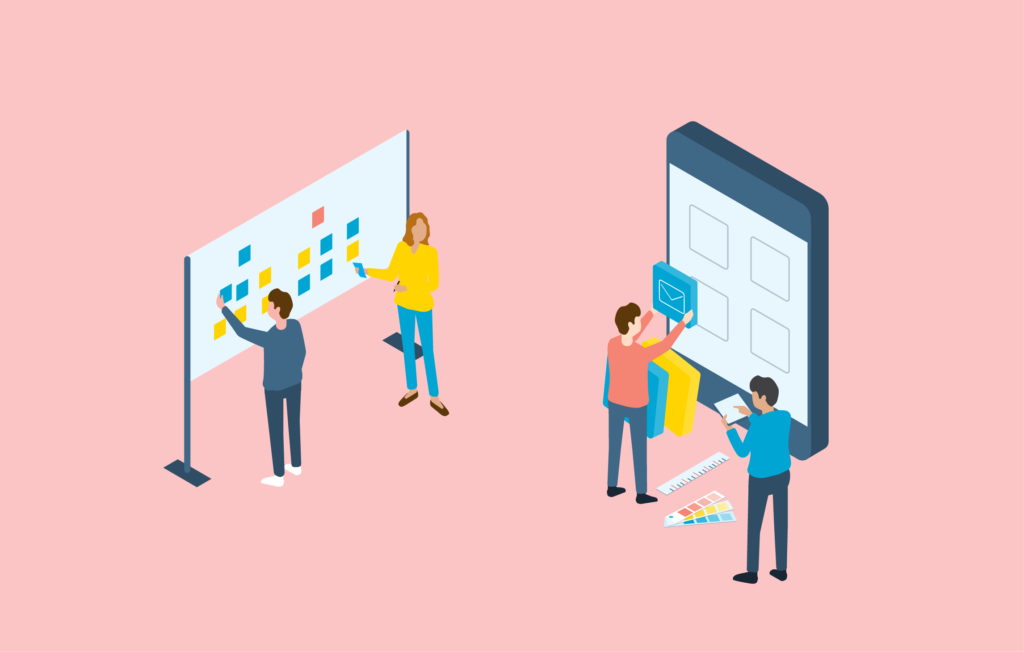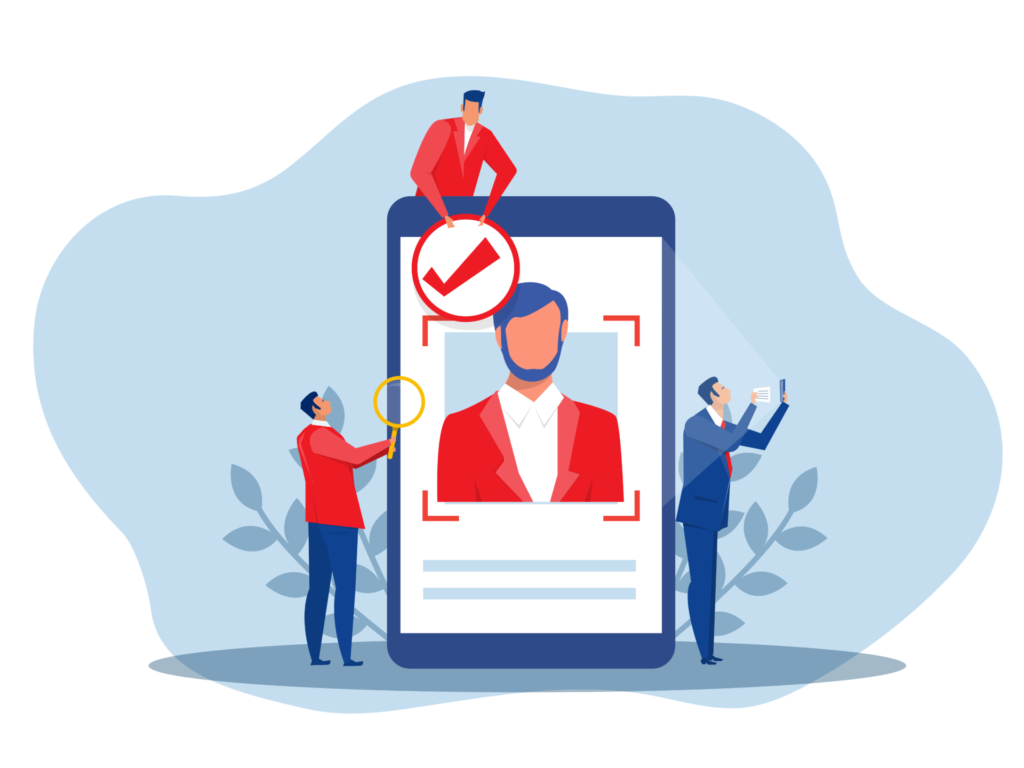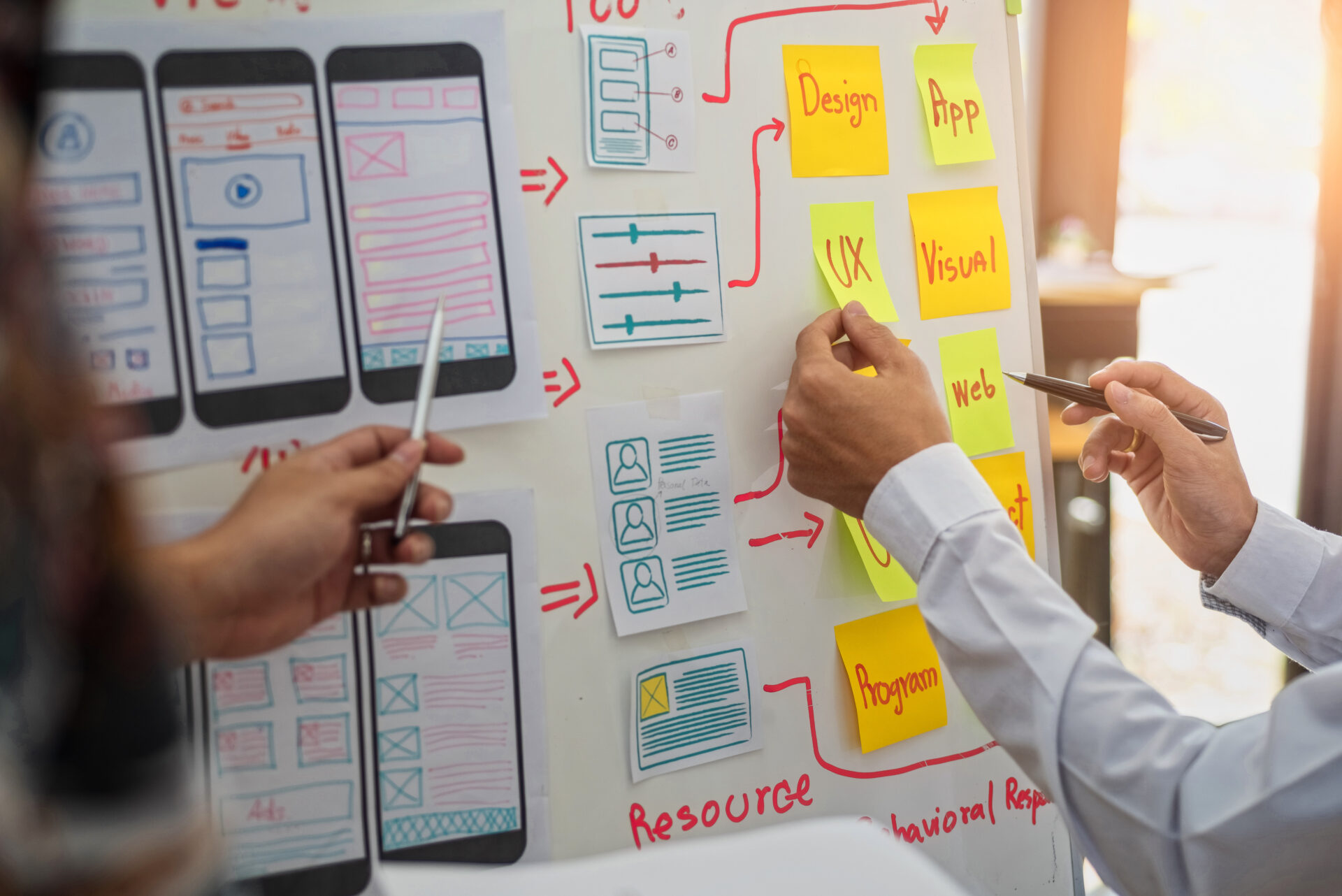في عصر أصبح فيه التفاعل الرقمي جزءًا أساسيًا من نجاح المؤسسات، ازدادت أهمية تجربة المستخدم (UX) بشكل كبير. بصفتنا وكالة تصميم وابتكار المنتجات الرقمية، ندرك أهمية تجربة المستخدم في تحقيق توقعات المستخدمين بل وتجاوزها. وهذا الأمر بالغ الأهمية خاصةً بالنسبة للمؤسسات الكبرى، حيث يتميز المشهد الرقمي بالتعقيد وبتحديات فريدة من نوعها.

ابتكارات تجربة المستخدم الرائجة
البقاء في صدارة الساحة الرقمية يتطلب وعيًا دقيقًا بالاتجاهات الناشئة في تجربة المستخدم. في عام 2023، تشمل الاتجاهات البارزة الذكاء الاصطناعي التوليدي، تنفيذ حجم الخط الكبير، تحسينات الوصولية، وضع الإضاءة الفاتحة، الواقع المعزز، وتخصيص التصميم المدفوع بالبيانات. التكيف مع هذه الاتجاهات لا يحسن تجربة المستخدم فحسب، بل يضمن أيضًا أن تظل منتجاتك الرقمية معاصرة وقادرة على المنافسة.
تعزيز دعم العملاء من خلال تجربة المستخدم
الكفاءة الداخلية وتصميم تجربة المستخدم
باختصار، يعد مجال تصميم تجربة المستخدم واسعًا، مع مجموعة متنوعة من الاستراتيجيات والتقنيات المتاحة لتحسين تجارب العملاء والموظفين على حد سواء. من خلال شراكتك معنا، فإنك لا تستثمر فقط في تصميم تجربة مستخدم من الدرجة الأولى، بل تضمن أيضًا أن تظل مؤسستك مرنة ومبتكرة وجاهزة لمواكبة متطلبات المشهد الرقمي المعاصر. وكالتنا ملتزمة بتقديم حلول تجربة مستخدم مخصصة تحقق نتائج أعمال ملموسة، مما يدفع مؤسستك قدمًا في جبهة المنافسة الرقمية اليوم.
دفع تأثير الأعمال من خلال تجربة المستخدم
مجال تصميم تجربة المستخدم (UX) واسع، ويشمل جوانب متعددة تؤثر بشكل كبير على نتائج الأعمال. عند تطبيقه بشكل فعال، يمكن لتصميم تجربة المستخدم أن يحقق عائدًا ملحوظًا على الاستثمار (ROI)، ويعزز احتفاظ العملاء—وهما عنصران حاسمان لاستدامة الأعمال ونموها.
عائد الاستثمار من تصميم تجربة المستخدم
مثال قوي على عائد الاستثمار من تصميم تجربة المستخدم يأتي من بنك أمريكا الذي بدأ مشروعًا لإعادة تصميم تجربة المستخدم لتحسين تطبيق التسجيل عبر الإنترنت للخدمات المصرفية عبر الإنترنت. من خلال التركيز على العائد (نسبة العملاء الذين أكملوا العملية) كمقياس أساسي، ومن خلال النمذجة واختبار حلول التصميم المختلفة، أثبتت استراتيجية إعادة التصميم نجاحها. في الأسبوع الذي تم فيه إطلاق نموذج التسجيل الجديد، تقارب مقياس العائد ليصبح ضعف ما كان عليه، متجاوزًا مقياس عائد الاستثمار المستهدف.

حتفاظ العملاء:
- فهم احتياجات العملاء:
- من خلال البحث المستخدم، الاستطلاعات، المقابلات، والتحليلات، يسهم تصميم تجربة المستخدم في فهم أعمق لاحتياجات العملاء وتفضيلاتهم ونقاط الألم لديهم، وهو أمر حاسم لإنشاء حلول تتماشى مع الجمهور المستهدف.
- تحديد ومعالجة سلوكيات “العلم الأحمر”:
- جانب أساسي في تصميم تجربة المستخدم هو القدرة على تحديد السلوكيات التي تشير إلى مشكلات، مثل النقاط التي يتوقف فيها العملاء عن إتمام عملية التسجيل. من خلال تحليل بيانات التراجع والمقاييس ذات الصلة، يمكن للشركات “سد الثغرات” لتحقيق أقصى النتائج وتحسين احتفاظ العملاء.
- تحسين التفاعل مع العملاء:
- اعتماد طرق اختبار لضمان أن المنتجات خالية من الأخطاء وتعمل كما هو مقصود، يوفر للمستخدم تجربة سلسة، مما يساعد الشركات على تحسين احتفاظ العملاء وزيادة تفاعلهم.
توضح الأمثلة والاستراتيجيات المذكورة الدور الهام لتصميم تجربة المستخدم في تحقيق نتائج تجارية إيجابية، سواء من حيث عائد الاستثمار أو احتفاظ العملاء. من خلال الاستثمار في تصميم تجربة المستخدم، لا تعزز الشركات رضا المستخدمين فقط، بل تضع أيضًا أساسًا قويًا للولاء طويل الأمد للعملاء، وهو أمر لا غنى عنه للحفاظ على ميزة تنافسية في سوق العمل الرقمي الحديث.

تعزيز الابتكار للميزة التنافسية:
فيما يتعلق بتصميم تجربة المستخدم مع التركيز على الابتكار وتجهيز المنتجات الرقمية للمستقبل للمؤسسات الكبرى، يمكن النظر في عدة جوانب لتقديم رؤية شاملة:
التمييز التنافسي من خلال تصميم تجربة المستخدم المبتكر:
- تجارب رقمية متميزة: من خلال التركيز على استراتيجيات وتصميم المنتجات التي تضع المستخدم في المقدمة، يمكن للمؤسسات إنشاء تجارب رقمية متميزة، مما يشعل الابتكار ويولد قيمة كبيرة، كما تم تسليط الضوء عليه في دراسة حالة من UXReactor.
- التصميم كميزة تنافسية: خاصة في الصناعات التي تشهد تآكلًا في الفروق، يقود التصميم التميز الفائز من خلال التجربة.
- الاستثمار في تجربة المستخدم كميزة تنافسية: في العصر الرقمي، يوفر الاستثمار في تصميم تجربة المستخدم ميزة تنافسية من خلال مساعدة الشركات على التميز والنجاح في الفضاء الإلكتروني.
آليات الابتكار في تجربة المستخدم:
- تحسين توافق السوق: المنتجات والخدمات التي تم تصوّرها من خلال البحث المستخدم، والدراسة الإثنوغرافية، والتفكير التصميمي تتمتع بتوافق أكبر مع السوق، مما يجعلها أكثر مرونة في مواجهة التحولات أو الاضطرابات في السوق.
- تعزيز الابتكار: المؤسسات التي تستثمر في التصميم الجيد تميل إلى أن تكون أكثر ابتكارًا، حيث تتخلى بسهولة عن الأساليب القديمة لتبني طرق تفكير جديدة وتوفير قيمة مضافة.
- إنشاء أنظمة تجارب: النظر إلى الأنظمة ككل، بدلاً من العزل، يمكن أن يؤدي إلى دمج أكثر تماسكًا لتجارب متكاملة من البداية إلى النهاية، مما يجعل من الصعب تعطيلها ويوفر قيمة إجمالية أكبر.
تحضير المنتجات الرقمية للمستقبل من خلال تصميم تجربة المستخدم:
- أنظمة التصميم كأساس: تعد أنظمة التصميم أساسًا لتحضير تجربة المستخدم للمستقبل، حيث تأخذ في الاعتبار احتياجات المستخدم ورغباته وقيوده، مما يضمن أن تظل التفاعلات مع المستخدم بديهية ومرتكزة على الأهداف مع مرور الوقت.
تسلط هذه النقاط الضوء على كيف أن تصميم تجربة المستخدم المدروس بعناية لا يعزز الابتكار فحسب، بل يمهد الطريق أيضًا للتمييز التنافسي والمرونة المستقبلية في المنتجات الرقمية. من خلال دمج التفكير التصميمي عبر العمليات التنظيمية والتكيف المستمر مع احتياجات المستخدمين وديناميكيات السوق، يمكن للمؤسسات تعزيز مكانتها في السوق بشكل كبير وجاهزيتها للتحديات المستقبلية.
تحسين الكفاءة والإنتاجية من خلال تصميم تجربة المستخدم (UX)
فيما يتعلق بموضوع تحسين الكفاءة والإنتاجية من خلال تصميم تجربة المستخدم، استفادت العديد من المنظمات الكبرى من مبادئ تجربة المستخدم لتبسيط العمليات، وتحسين تفاعل الموظفين مع الأدوات الداخلية، وتعزيز الإنتاجية العامة. إليك تفصيل لكيفية مساهمة تجربة المستخدم في تعزيز الكفاءة والإنتاجية، مدعومًا بأمثلة حقيقية:
تبسيط العمليات:
- تصميم المواد من جوجل:
- بحث المستخدم من Airbnb:
تسلط هذه الأمثلة الضوء على إمكانيات تصميم تجربة المستخدم المدروس في تبسيط العمليات وتحسين الإنتاجية، ليس فقط ضمن المنصات الرقمية ولكن أيضًا في كيفية تفاعل الموظفين مع هذه المنصات. من خلال التحليل الدقيق، والتصميم التكراري، والتغذية الراجعة من المستخدمين، يمكن للشركات تحسين الكفاءة بشكل كبير، وتقليل وقت التدريب، وفي النهاية المساهمة في تحقيق نتائج أعمال أفضل.
كشف مخطط تجربة المستخدم الفعالة: بحث المستخدم العميق والنتائج القابلة للقياس
في عالم التصميم الرقمي المتطور باستمرار، يُعتبر فهم المستخدم حجر الزاوية لإنشاء تجارب لا تقتصر على التأثير فحسب، بل تدفع أيضًا بنجاح الأعمال. تبدأ هذه الرحلة من الفهم من خلال بحث المستخدم، وهو عنصر أساسي في عملية تصميم تجربة المستخدم بشكل عام. الأمر لا يتعلق فقط بالجمالية أو واجهة الاستخدام؛ بل هو يتعلق بالغوص العميق في احتياجات المستخدمين وسلوكياتهم والتحديات التي يواجهونها. وبالتالي، فإن الرؤى المستخلصة من بحث المستخدم تصبح المصدر الرئيسي لقرارات التصميم، مما يضمن أن الحلول المطروحة ليست جذابة بصريًا فحسب، بل أيضًا عملية ومركزة على المستخدم.
بحث المستخدم: بوصلة توجيه التصميم
يُعد بحث المستخدم بمثابة البوصلة التي توفر اتجاهًا واضحًا في بحر الإمكانيات الواسع لتصميم تجربة المستخدم. يتضمن الأمر التعرف على المستخدمين المستهدفين، وفهم من تصمم له، ولماذا، والمشاكل التي يواجهها المستخدمون بالنسبة للمنتج أو الخدمة الخاصة بك1. مثال عملي على ذلك هو كيف استفادت Airbnb من ملاحظات سلوك المستخدمين لاكتشاف فرص التصميم. من خلال البحث المنظم للمستخدمين، تمكنت Airbnb من فهم التفاعلات وتفضيلات المستخدمين، مما أدى إلى تحسين حلول التصميم2.
علاوة على ذلك، استخدمت عمالقة التقنية مثل أمازون و Airbnb و Dropbox قوة بحث المستخدم لتحسين تجربة المستخدم الخاصة بها، مما يبرز الدور الحاسم الذي يلعبه في تعزيز التصميم وتجربة المستخدم في النهاية3. إنه مسعى يتجاوز الافتراضات، ويقدم أساسًا ملموسًا يمكن أن تزدهر عليه أفكار التصميم. كما يوضح CareerFoundry، يهدف بحث المستخدم إلى التصميم لتلبية احتياجات المستخدم الفعلية، وليس ما نفترضه عن احتياجاته. إنه يفتح عالمًا من إمكانيات التصميم، مما يضمن الحصول على ميزة تنافسية ويوفر الوقت والمال4.
الانتقال من الرؤية إلى القياس: دور مؤشرات الأداء الرئيسية (KPIs)
الانتقال من الرؤى المستخلصة من بحث المستخدم إلى المجال القابل للقياس هو المكان الذي تدخل فيه مؤشرات الأداء الرئيسية (KPIs). تعد مؤشرات الأداء الرئيسية أداة أساسية لقياس وتوثيق أداء جهود تجربة المستخدم5. فهي توفر وسيلة قابلة للقياس لتتبع وتحليل مجموعة متنوعة من المقاييس المتعلقة بتجربة المستخدم، مما يوفر رؤى قيمة حول كيفية تفاعل المستخدمين مع التصاميم وأين تكمن مجالات التحسين6.
بعض مؤشرات الأداء الرئيسية الشائعة في تجربة المستخدم (KPIs) تشمل مقاييس مثل رضا المستخدم، معدل إتمام المهام، و معدل الارتداد، والتي يمكن جمعها من خلال عدة طرق مثل الاستطلاعات، التحليلات، واختبار المستخدمين7. على سبيل المثال، قد تتتبع فرق التسويق التي تهدف إلى زيادة الوعي بالعلامة التجارية مقاييس مثل معدل نمو المتابعين على منصات التواصل الاجتماعي و الإشارات إلى العلامة التجارية، مما يوفر نهجًا قابلًا للقياس لتقييم فعالية استراتيجيات تجربة المستخدم8.
في الختام، يشكل التناغم بين بحث المستخدم العميق و النتائج القابلة للقياس من خلال مؤشرات الأداء الرئيسية الأساس لتصميم تجربة مستخدم فعّالة. إنه مخطط يضمن ليس فقط واجهة مستخدم بصرية ممتعة ولكن أيضًا تصميمًا موجهًا نحو المستخدم يتناغم مع احتياجاته ويحقق أهداف الأعمال.
ضمان الامتثال وإمكانية الوصول:
إن معالجة تعقيدات تجربة المستخدم في مجال الامتثال الرقمي و التصميم الشامل أمر بالغ الأهمية لأي منظمة تسعى لإنشاء منتجات رقمية مسؤولة وقابلة للوصول. فيما يلي، يتوسع النقاش حول هذين الجانبين الحاسمين:
ضمان الامتثال الرقمي:
- فهم المتطلبات التنظيمية:
- تقابل كل صناعة تقريبًا إشرافًا تنظيميًا، والذي يهدف بشكل أساسي إلى حماية خصوصية المستهلكين، وأمنهم، وأحيانًا سلامتهم الجسدية. تشمل اللوائح الإرادة الجماعية للمجتمع وتعد امتدادًا لممارسات التصميم الأخلاقي1.
- الانخراط المبكر والتعاون:
- يجب ألا يُنظر إلى المتطلبات التنظيمية على أنها قيود، بل كمدخلات تشكل عملية التصميم. حوالي 95% من متطلبات المنتج تأتي من التسويق أو تطوير المنتجات، وليس من الجوانب التنظيمية أو الامتثال. لذلك، يمكن أن تزدهر الحلول المبتكرة ضمن بيئة ثقيلة بالامتثال1.
- تصميم تجربة المستخدم المبتكر ضمن إطار الامتثال:
- يمكن أن يمنع التفاعل مع متطلبات الامتثال من المراحل المبكرة لتصميم المنتج التعديلات المكلفة في التصميم لاحقًا. على سبيل المثال، في قطاع الاتصالات، أدى التعاون مع محامي الامتثال لتحقيق متطلبات FCC الخاصة بأمن البيانات إلى إطلاق ناجح لنظام أمني جديد، مع الالتزام بالموعد النهائي التنظيمي1.
تقدم التصميم الشامل:
- Universal Usability:
- The core objective of UX is to design products that cater to every potential user, irrespective of their abilities. The best UX is deemed as accessible UX2.
- Examples of Inclusive Design:
- Inclusive design has been showcased in various case studies, one of which is the creation of Good Grips kitchen utensils by OXO, designed to address usability for all individuals3.
- Methodological Approach:
- Inclusive design emanates from digital environments and seeks to include and learn from a diverse range of human perspectives. It’s a methodology that embraces the full spectrum of human diversity4.
- Commercial Implementation:
- Case studies reflect how inclusive design can foster innovation and enhance design in a commercial setting. It melds inclusivity with style, resulting in products that are both comfortable and effective5.
- Adherence to Legal Standards:
- Inclusive design also aligns with legal standards such as the American Disabilities Act (ADA) of 1990, ensuring digital products are accessible to a diverse user base6.
These elucidations underscore the significance of intertwining digital compliance and inclusive design within the UX framework, which not only aligns with legal and ethical standards but also broadens the scope of usability, fostering a more inclusive digital landscape.
Embracing technological advancements within the realm of User Experience (UX) design
In addressing the topic of embracing technological advancements within the realm of User Experience (UX) design, there are two primary subpoints: the integration of emerging technologies and the necessity of mobile optimization. Here’s a breakdown of each subpoint with reference to the latest trends and real-world examples.
Integrating Emerging Technologies: AI, VR, and AR
Emerging technologies such as Artificial Intelligence (AI), Virtual Reality (VR), and Augmented Reality (AR) are significantly impacting the UX design landscape. These technologies are extending the boundaries of digital design by opening new avenues for creating immersive and interactive user experiences. Unlike traditional 2D interfaces, AR and VR enable a 3-dimensional interaction space, allowing users to interact with digital content in a more natural and engaging manner1.
Moreover, AR and VR are no longer confined to gaming; they are stepping into the limelight of UX design. For instance, envision a scenario where while shopping for a new couch, you can place a virtual version of it right next to your coffee table in your living room. This level of interaction and visualization is becoming a reality in 2023, making the shopping experience more interactive and informed2.
AI, along with other technologies like Machine Learning and the Internet of Things (IoT), is reshaping almost every industry globally, and UX design is certainly no exception. These tech innovations are evolving rapidly, posing a challenge and an opportunity for UX designers to keep up and leverage these technologies to enhance user experiences3.
Mobile Optimization
The necessity for mobile optimization in UX design stems from the widespread prevalence and usage of smartphones and tablets. Although not covered in the sourced materials, it’s well understood in the industry that ensuring a seamless user experience on mobile devices is crucial as the number of mobile users continues to grow. A mobile-optimized UX design ensures that the digital product is easily accessible, navigable, and usable on various mobile devices, thus meeting the expectations of modern users.
In conclusion, the integration of emerging technologies like AI, VR, and AR, along with mobile optimization, are pivotal in enhancing the UX design, making it more interactive, engaging, and accessible across various devices. By embracing these technological advancements, UX designers can create innovative solutions that meet the evolving needs and expectations of users in this digital era.
Fostering collaboration and seamless integration in the realm of User Experience (UX)
Addressing the various facets of fostering collaboration and seamless integration in the realm of User Experience (UX) is crucial for the success of digital projects within large organizations. Here’s an elaborated discussion on Point 7 and its subpoints:
Promoting Collaboration and Seamless Integration:
1. Cross-Functional Collaboration:
- Strategies for Fostering Collaboration:
- Early Engagement: It’s recommended to involve developers as stakeholders early in the design process, ensuring that they have a say in the UX design from the beginning, which is crucial for fostering a collaborative environment1.
- Regular Check-ins: Having frequent check-ins between designers, developers, and stakeholders is essential to ensure everyone is aligned and to facilitate the iterative nature of the UX design process1.
- Shared Goals: Establishing shared goals among UX designers, developers, and various teams can streamline processes and create better products that meet user needs and business objectives2.
- Benefits of Collaboration:
- Better Products: Collaboration between UX designers and other stakeholders is essential for creating user-centered products that not only address user needs but also streamline internal processes3.
- Learning Opportunities: Collaborative settings offer valuable opportunities for all involved parties to learn how users interact with products and services firsthand, fostering a shared understanding and alignment4.
2. Seamless Integration:
- Integration with Existing Systems:
- While the sources didn’t provide specific examples or methods, it’s generally known in the industry that seamless integration of new UX designs with existing systems and technologies is a complex yet crucial task. It ensures that the new designs work harmoniously with the existing infrastructure, minimizing disruptions and ensuring a smooth transition.
- Challenges and Solutions:
- Again, while the specifics weren’t covered in the sources, it’s well understood that challenges may arise due to technological, process, or cultural differences within large organizations. Solutions may include thorough planning, effective communication, and possibly leveraging middleware or other integration technologies to bridge the gap between new and existing systems.
The synthesis of the information suggests that promoting a culture of collaboration and ensuring seamless integration are pivotal in navigating the complex landscape of UX design within large organizations. By engaging stakeholders early, aligning on shared goals, and addressing integration challenges head-on, organizations can significantly enhance the quality and impact of their digital products.
Building for Scalability and Continuous Growth
In an ever-evolving digital landscape, scalability and continuous growth are paramount for large organizations aiming to stay competitive and meet the expanding needs of their user bases. Your agency can play a pivotal role in aiding enterprises on this front through the development of scalable design systems and the implementation of user feedback loops.
Scalable Design Systems Development:
Scalable design systems are essentially a collection of repeatable design patterns, guidelines, and coded components that allow organizations to maintain consistency while scaling their digital products across different platforms and user interfaces.
- Examples of Scalable Design Systems:
- ABB: The Switzerland-based holding company ABB created a design system to ensure a consistent look and feel across hundreds of software products, many of which power the mechanical systems in factories, mines, and other industrial sites1.
- IBM Carbon: IBM’s Carbon Design System is another exemplary case of a scalable design system that provides a suite of tools, including UI kits and guidelines for designers, developers, and content authors2.
- Benefits:
- Efficiency: By using a system of reusable components and patterns, organizations can build and iterate on designs more efficiently, saving both time and resources3.
- Consistency: Ensures a cohesive user experience across all digital touchpoints, which is crucial for brand recognition and user satisfaction4.
- How Your Agency Can Help:
- Custom Design System Development: Tailor design systems to the unique needs and branding of each client.
- Design System Audit and Optimization: Evaluate existing design systems and suggest improvements for better scalability and efficiency.
- Training and Documentation: Provide training and comprehensive documentation to ensure smooth adoption and ongoing maintenance of the design system.
User Feedback Loops:
User feedback loops are systematic processes of collecting, analyzing, and acting upon user feedback to continuously improve the user experience.
- Benefits:
- Implementing User Feedback Loops:
- Collecting Feedback: Utilize various channels such as surveys, social media, and user interviews to collect feedback.
- Analyzing Feedback: Analyze the feedback to derive actionable insights that can help enhance the user experience.
- Acting on Feedback: Make necessary adjustments to the product based on the feedback collected and analyzed.
- How Your Agency Can Help:
- Feedback System Setup: Assist in setting up systems and processes for collecting and analyzing user feedback.
- Feedback Analysis Services: Provide services for analyzing user feedback and deriving actionable insights.
- Iterative Design and Development: Work closely with clients to iteratively design and develop improvements based on user feedback.
Through the strategic development of scalable design systems and the implementation of user feedback loops, your agency can significantly contribute to the scalability and continuous growth of large organizations in the digital realm. By offering custom solutions and expert guidance, you can help clients adapt to changing market demands, maintain a competitive edge, and deliver exceptional user experiences.
Customization & Personalization in User Experience Design
In addressing the topic of customization and personalization in User Experience (UX) design, a multitude of strategies and real-world applications can be observed. These are aimed at tailoring the user interface and experience to meet individual preferences and needs, which in turn, significantly enhances user engagement and satisfaction. Here are some of the sub-points fleshed out, with references to external sources for further insights:
- Types of Personalization:
- Explicit Personalization: This involves customizing content or product recommendations based on explicit information or preferences provided by the user, such as demographic information and interests1.
- Implicit Personalization: This type relies on analyzing user actions like search history and previous purchase history to understand user preferences and provide personalized recommendations accordingly1.
- Contextual Personalization: Factors like location, device type, time of day, weather, or other contextual cues are considered to tailor content or product recommendations, leveraging real-time data1.
- Examples of Personalization Strategies in UX Design:
- Personalized Dashboards and Home Pages: Customizing the main page and/or the dashboard that welcomes users to the product is a common personalization technique. This provides a sense of familiarity and comfort, enhancing user satisfaction1.
- Personalized Content Suggestions: By analyzing user behavior, platforms can suggest content that aligns with the user’s preferences and interests, enhancing engagement and satisfaction2.
- Personalized Onboarding: Tailoring the onboarding process to individual users can help in making the user feel valued, and can also provide a smoother transition into using the platform2.
- Real-World Examples:
- Amazon: Amazon personalizes the home page based on your purchase history, wishlist, and recent search history to provide product recommendations, making it easier for users to discover new items that align with their interests1.
- Netflix: Netflix is renowned for its personalized recommendations. It utilizes viewing history to suggest shows and even personalizes the thumbnails shown to different users based on their genre preferences1.
- Airbnb: The platform personalizes the home page based on upcoming stays and recommends locations within driving distance of the user’s current location, enhancing the overall user experience3.
- Benefits of Personalization:
- Increased User Engagement: Personalization increases relevance, which in turn, increases user engagement. For instance, emails with personalized subject lines witness a 26% rise in open rates4.
- Enhanced User Satisfaction: Users are more likely to be satisfied with a platform that caters to their personal preferences and needs.
- Hyper-Personalization:
- A step beyond traditional personalization, hyper-personalization understands the context alongside past behavior to provide highly tailored experiences. It’s about leveraging real-time data to offer a more granular level of personalization5.
- Challenges and Considerations:
- Privacy Concerns: As personalization relies on data collection, ensuring data privacy and compliance with regulations is crucial.
- Technical Complexity: Implementing personalization at scale requires robust technological infrastructure and capabilities.
By understanding and leveraging the different facets of personalization in UX design, platforms can significantly enhance the user experience, leading to better user engagement, satisfaction, and ultimately, business success.
Case studies and best practices in the field of UX design
In this section, we’ll delve into some riveting case studies and best practices in the field of UX design, illustrating how meticulous attention to user experience can significantly amplify the success of digital projects. These real-world examples underscore the transformative power of UX design in solving complex problems, enhancing user satisfaction, and ultimately, driving business growth.
- Mercedes-Benz Ukraine Car Dealer Website Redesign by Fulcrum:
- Project Brief: The task was to transition from a template-based website to a custom-designed, user-friendly platform that could bolster user trust and streamline maintenance.
- Outcome: A well-structured, intuitive website that enhanced user interactions, facilitating easy access to services and products offered by Mercedes-Benz Ukraine1.
- Galaxy Z Flips 5G Website by DFY:
- Project Brief: This project entailed the comprehensive design of a website to effectively illustrate and demonstrate the upgrades of the Galaxy Z Flip 5G over previous models, while fostering interactive communication with customers.
- Outcome: A visually engaging, interactive platform that provided clear, accessible information on the product features, thus enhancing user engagement and satisfaction1.
- Jambb Social Platform by Finna Wang:
- Project Brief: The goal was to create a platform to assist creators in growing their communities by recognizing and rewarding their supporters, addressing the challenge of acknowledging non-monetary contributions.
- Outcome: A platform designed with comprehensive user flows, wireframes, and usability testing, eventually fostering a more inclusive, rewarding environment for both creators and their supporters1.
- GnO Well Being – Branding, Web Design & UX:
- Project Brief: The task was to design a creative illustration website to present and sell a designer blanket aimed at promoting better sleep and overall health.
- Outcome: A well-crafted, user-centric website that effectively conveyed the brand message and facilitated user interactions2.
- Liquidplanner’s Usability Improvement:
- Project Brief: Liquidplanner, a cloud-based project management system, needed a solution to help users create dashboards more efficiently.
- Outcome: Through a meticulous UX design process, the usability of the system was significantly improved, enabling quicker dashboard creation and enhancing user satisfaction3.
- The UX Fund Experiment:
- Project Brief: An experiment named the “UX Fund” was initiated with a $50,000 investment in companies focusing on delivering superior user experiences, with a hypothesis that the ROI of UX would be reflected in their stock prices over time.
- Outcome: Over a ten-year period (2006 to 2016), the “UX Fund” yielded a remarkable 450% return, underlining the long-term financial viability of investing in superior UX design4.
These compelling case studies exhibit the vast spectrum of challenges that can be adeptly addressed through proficient UX design, reaffirming the importance of investing in user experience to achieve notable business outcomes. Moreover, they serve as a testament to the multifaceted value that our agency can bring to your organization by meticulously crafting user-centric digital solutions tailored to your unique needs and objectives.
Elevating Digital Prowess: Unveiling New Avenues for UX Mastery”
In the swiftly evolving digital landscape, staying ahead necessitates a continual refinement of skills and understanding of the latest User Experience (UX) trends. Engaging with an agency committed to empowering teams with the requisite knowledge and expertise ensures that digital products not only resonate with audiences but also drive tangible business outcomes. Here’s how a well-equipped agency can fuel a journey towards UX mastery:
- Workshops and Training Sessions:
- Comprehensive Courses: A rich learning experience is provided through all-encompassing courses on UX and UI design, akin to offerings by Experience Haus, where real projects form the core of the learning trajectory1.
- Flexible Learning Modalities: Whether on-site or online, tailored training programs, much like those from the American Graphics Institute, fit varied schedules and learning preferences, from short-term classes to multi-week certification programs2.
- Enterprise-centric Workshops: Specialized workshops, reminiscent of the Enterprise UX & UI Design Workshop by Tonex, are crafted to address the unique UX challenges encountered in large organizational settings, honing a team’s expertise to excel in UX and UI design3.
- Curated UX Workshops:
- Problem-Solving Workshops: Engage in UX workshops designed to unravel design challenges and foster cross-functional collaboration, akin to the methodologies espoused by Nielsen Norman Group4.
- Continuous Learning Opportunities:
- Subscription-based Learning: A subscription-based learning platform provides an avenue for teams to access updated materials, webinars, and interactive sessions on the latest UX trends and best practices.
- Accredited Learning Collaborations: Through partnerships with educational institutions, accredited UX design courses are offered, ensuring a gold standard of learning and certification.
- Industry Engagement:
- Interactive Industry Events: Engaging with the global UX community through hosted or sponsored UX design events, conferences, and meetups paves the way for networking and collective learning.
- Expert-Led Sessions: Benefit from sessions conducted by industry veterans, shedding light on emerging UX technologies and methodologies, thereby fostering a culture of knowledge sharing and continuous dialogue.
- Online Resources:
- Resourceful Online Library: A well-stocked online library with insightful articles, videos, and case studies on UX design facilitates self-paced learning and reference.
- Monthly UX Digest: Monthly newsletters encapsulate the latest UX trends, case studies, and best practices, ensuring a constant update with the evolving UX domain.
- Feedback-Driven Improvement:
- Feedback Channels: Post-training feedback surveys are integral to a learning-centric approach, helping gauge the effectiveness and relevance of the training content.
- Ever-evolving Course Material: Continuous refinement of course material based on the latest industry trends, feedback, and technological advancements ensures the learning experience remains relevant and up-to-date.
Engaging with an agency offering a plethora of learning opportunities elevates UX acumen to new heights, ensuring digital endeavors are not only user-centric but also competitively advantageous in the bustling digital marketplace. The journey towards superior digital innovation begins with a single step – and having a dedicated agency provides guidance every step of the way, ensuring a prosperous digital voyage.

الخاتمة
In traversing the complex landscape of digital innovation, the pivotal role of User Experience (UX) design cannot be overstated. It’s an indispensable asset that underpins the success of digital platforms, ensuring they resonate with the users while meeting the strategic business objectives. Our agency is adept at navigating this intricate domain, offering a blend of expertise, innovation, and a meticulous approach to design that is data-driven and user-centric.
As delineated throughout this article, our comprehensive services address a multitude of UX facets—from driving business impact to ensuring compliance and accessibility. We are committed to fostering a collaborative environment that transcends departmental silos, ensuring seamless integration and alignment with your organization’s broader goals. By leveraging the latest technological advancements and adhering to industry best practices, we provide a robust foundation for your digital products to thrive in a competitive market.
Moreover, our emphasis on education and continuous learning ensures that your team remains at the forefront of UX design trends, equipped with the knowledge and skills necessary to sustain a trajectory of growth and innovation.
We invite you to engage with us for a personalized consultation. Let’s explore together how our adept design strategies and solutions can be tailored to meet your unique needs, ensuring your digital platforms not only meet but exceed the expectations of your users, thereby driving enhanced satisfaction, loyalty, and business success.
In a world where the digital experience is often the first and most enduring interaction your customers have with your brand, investing in superior UX design is not merely a good practice—it’s a business imperative. Our agency is poised to be your trusted partner in this endeavor, propelling your digital presence to new heights of excellence.





